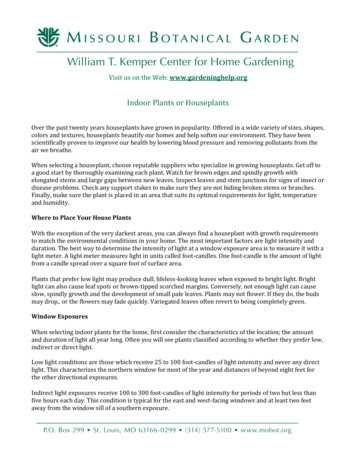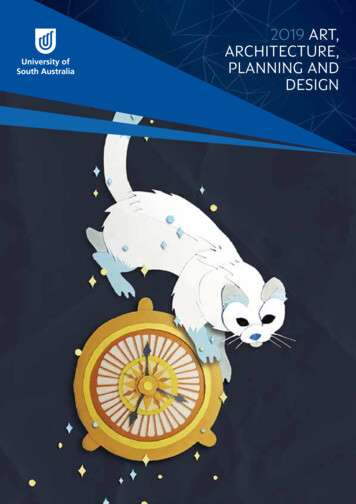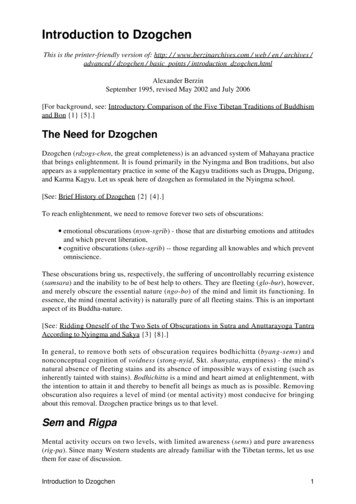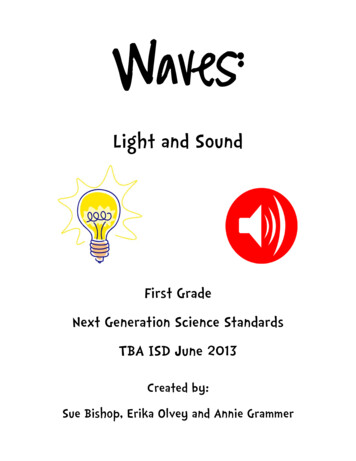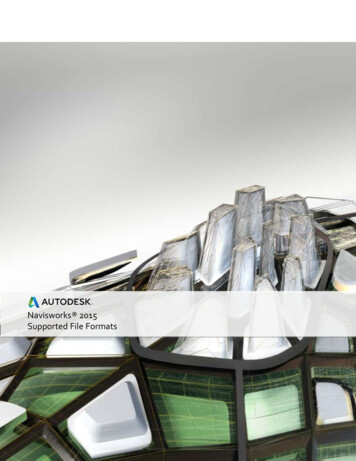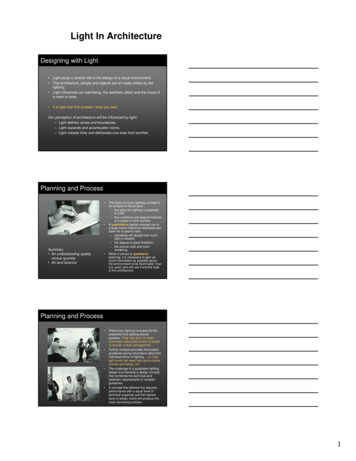
Transcription
Light In ArchitectureDesigning with Light Light plays a central role in the design of a visual environment.The architecture, people and objects are all made visible by thelighting.Light influences our well-being, the aesthetic effect and the mood ofa room or area.It is light that first enables “what you see”.Our perception of architecture will be influenced by light:– Light defines zones and boundaries,– Light expands and accentuates rooms,– Light creates links and delineates one area from another.Planning and Process Summary An understanding qualityversus quantity Art and Science The basis for every lighting concept isan analysis of the project – the tasks the lighting is expectedto fulfill,– the conditions and special featuresof a space or work surface.A quantitative design concept can toa large extent follow the standards laiddown for a specific task.– standards will dictate how muchlight is needed,– the degree of glare limitation,– the source color and colorrendering.When it comes to qualitativeplanning, it is necessary to gain asmuch information as possible aboutthe environment to be illuminated, howit is used, who will use it and the styleof the architecture.Planning and Process Preliminary lighting concepts list theproperties that lighting shouldpossess. They may give no exactinformation about the choice of lampsor fixtures or their arrangement.Further analysis provides illuminationguidelines giving information about theindividual forms of lighting i.e. highlight levels will need high performancefixtures and lamps, etc.The challenge of a qualitative lightingdesign is to develop a design conceptthat combines the technical andaesthetic requirements of complexguidelines.A concept that delivers the requiredperformance with a equal level oftechnical expertise and the highestlevel of artistic clarity will produce themost convincing solution.1
Light In ArchitecturePlanning and Process Summary Utilization of Space Psychological Requirements Architecture and Ambience As the design phase progresses,decisions are made regarding:– the lamps and fixtures to be used– the arrangement and installation ofthe fixtures– any required electrical and controldevicesThe decision regarding lamp type canbe made at the beginning of a projector left until an advanced planningstageLighting layouts (the plan) can bedetermined by the choice of a lightfixture or could be the criteria forfixture selection.Lighting design process should beseen as a “back and forth” check inwhich developed solutions arerepeatedly compared to thepredetermined goals andrequirements.Types of LightingTypes of Lighting2
Light In ArchitectureForming Functional Zones Distinct contrasts betweenindividual zones and theirsurroundings remove themfrom their spatial context.room with left wall illuminated (simulate daylight)Forming Functional ZonesForming Functional Zones - Exterior3
Light In ArchitectureForming Functional Zones - ExteriorDefining Spatial Borders - Horizontal Floor illuminationemphasizes objects andpedestrian surfaces.floor lit with downlight fixturesDefining Spatial Borders - Horizontal Indirect lighting of a ceilingcreates diffuse light in theroom with the lightingeffect being influenced bythe reflectance and colorof its surface.ceiling uniformly lit with uplight wall fixtures4
Light In ArchitectureDefining Spatial Borders – HorizontalDefining Spatial Borders – HorizontalDefining Spatial Borders - Vertical walls uniformly lit with wall fixtures Vertical spatial borders are emphasizedby illuminating wall surfaces.Uniform light distribution emphasizes thewall as a whole.Bright walls create a high level of diffuselight in the room.Vertical illumination is used to shape thevisual environment.Room surfaces can be differentiatedusing different levels of illuminance toindicate their importance.Uniform illumination of the surfacesemphasizes them as an architecturalfeature.5
Light In ArchitectureDefining Spatial Borders - Vertical Vertical spatial borders are emphasizedby illuminating wall surfaces.Uniform light distribution emphasizes thewall as a whole.Bright walls create a high level of diffuselight in the room.Vertical illumination is used to shape thevisual environment.Room surfaces can be differentiatedusing different levels of illuminance toindicate their importance.Uniform illumination of the surfacesemphasizes them as an architecturalfeature.Defining Spatial Borders - Vertical Grazing light gives the wall structure byadding patterns of light.A decreasing level of brightness across awall is not as effective as uniform wallwashing at defining room surfaces.Lighting effects using grazing lightemphasis the surface textures andbecome the dominant feature.Defining Spatial Borders - Vertical6
Light In ArchitectureDefining Spatial Borders - VerticalDefining Spatial Borders - VerticalEmphasizing Architectural Features The illumination of architectural detailsdraws attention away from the room asa whole towards individualcomponents.Columns appear as silhouettes in frontof an illuminated wall.walls lit with grazing fixtures7
Light In ArchitectureEmphasizing Architectural Features Rooms can be given a visual structureby illuminating the architecturalfeatures.Narrow-beam downlights emphasizingthe form of the columns.columns lit with grazing fixturesEmphasizing Architectural Features Grazing light accentuates individualelements or areas and brings out theirform and surface texture.Grazing light can cause highly threedimensional features to cast strongshadows.By using different levels of illuminance,different parts of a room can be placedin a visual hierarchy.Emphasizing Architectural Features8
Light In ArchitectureVisual ClarityVisual ClarityLayout and Pattern for clarity9
Light In ArchitectureLayout and Pattern for architectural relationshipsLayout and Pattern for functionPsychology of LightBecause the sense of sight is contrast sensitive, the brightnesscontrast of a space determines its emotional impactEmotional Impact: individual impressions of a space are a functionof brightness contrast–the relationship of surfaces that are lighted to those left in thedark–the focus or foreground to the surround or backgroundGeneral illumination in a room will permit vision. The emotionalimpact of an interior through the manipulation of brightness contrastis a real challenge for the creative lighting designer.10
Light In ArchitectureEmotional ImpactEmotional ImpactDegrees of StimulationAll activities benefit from some form of visual stimulation–High levels encourage participation and increase enjoyment–Low levels help a person feel contented, comfortable,focused, and relaxedAlthough individuals react differently to the same environment,there is a high degree of similarity in people’s reactions to light.11
Light In ArchitectureDegrees of StimulationEnvironments that are complex, crowded, asymmetrical, novel,unfamiliar, surprising, random are High-load.Environments that are simple, uncrowded, symmetrical, conventional,familiar, unsurprising, or organized are Low-load.Degrees of StimulationEnvironmentalist use the terms High-load to Low-load to describe thedegrees of stimulation of arousal.The more stimuli that must be processed by a person, the higher theload.Degrees of Brightness ContrastThe degree of brightness contrast evokes emotions in the same way asbackground music. It affects . the performance of task, influences the behavior of people at work or play, and Impact the amount of containment and pleasure we experience.The degree of brightness contrast establishes the emotional setting, which eitherenforces or undermines the intended activity.Steps in the design process:1. Define the activity that will occur in the space2. Determine the degree of simulation that will enforce the activity3. Establish the degree of brightness contrast that will yield the necessary levelof simulationBrightness contrast is established be developing patterns of light and shade –select which surfaces to receive light or leave other is darkness12
Light In ArchitectureDegrees of Brightness ContrastLow Contrast Environment – everything is of equal emphasisDegrees of Brightness ContrastLow Contrast Environment – everything is of equal emphasisDegrees of Brightness ContrastLow Contrast Environment – everything is of equal emphasis13
Light In ArchitectureDegrees of Brightness ContrastMid Contrast Environment – combinations of emphasisDegrees of Brightness ContrastMid Contrast Environment – combinations of emphasisDegrees of Brightness ContrastHigh Contrast Environment – high bright and dark areas14
Light In ArchitectureDegrees of Brightness ContrastHigh Contrast Environment – high bright and dark areasDegrees of Brightness ContrastVery High Contrast Environment – extreme high bright and dark areasDegrees of Brightness ContrastVery High Contrast Environment – extreme high bright and dark areas15
Light In ArchitectureSubjective Impressions1. Direct lighting on table strong contrast, too harshfor lighting facesPleasantness: NeutralClarity: Hazy, quiet impressionSpaciousness: Strong impression of confinement2. Lighting on all walls, low intensity, suitable fordisplayPleasantness: Neutral, tending towards a morepleasant impressionClarity: NeutralSpaciousness: Promotes impression ofspaciousness, increased height3. Lighting of cove above, low intensity, pleasant fornear and distant facesPleasantness: Strong negativeClarity: Strong promoting hazy, quiet impressionSpaciousness: Neutral4. Direct lighting on table, Lighting of small wallPleasantness: Relatively Strong positiveClarity: NeutralSpaciousness: Neutral with strength in impressionof length5. Direct lighting on table, Lighting of cove abovesoft subdued effect, pleasant for near facesPleasantness: Relatively Strong negativeClarity: StrongSpaciousness: Somewhat6. Lighting of cove above, Lighting of walls flatshadow freePleasantness: StrongClarity: StrongSpaciousness: StrongSubjective ImpressionsImpression of Spaciousness – the room appears larger or smallerSubjective ImpressionsImpression of Perceptual Clarity – the room appears public or private16
Light In ArchitectureSubjective ImpressionsImpression of Pleasantness – the room appears friendly of sociableThe Three Elements of LightGeneral or Ambient lightingprovides an area with overall illumination. Also known as ambient lighting,general lighting radiates a comfortable level of brightness, enabling one tosee and walk about safely.Task Lighting or Lighting at the Work planehelps you perform specific tasks such as reading, sewing, cooking,homework, hobbies, games, or balancing your checkbookLight or Highlightingadds drama to a room by creating visual interest. As part of a decoratingscheme, it is used to spotlight paintings, houseplants, sculpture, and otherprized possessions, or to highlight the texture of a wall, drapery or outdoorlandscaping.Richard KellyGeneral or Ambient light is “a snowy morning in open country”“twilight haze in a mountain top or cloudy day on the ocean”“the light in a white tent at noon”17
Light In ArchitectureRichard KellyFocal Glow or Task light is “the campfire of all time, the glowing embers around which stories are told”“the light burning at the window or welcoming gleam of the open door”“directive, creates a brighter center: tells us what to look at, organizes, marks theimportant element”Richard KellySparkle or Glitter is “a play of brilliants”“the sensation of a cache of diamonds in an opened cave”“a ballroom of crystal chandeliers”18
Light In Architecture Designing with Light Light plays a central role in the design of a visual environment. The architecture, people and objects are all made visible by the lighting. Light influences our well-being, the aesthetic effect and the mood of a room or area. It is

